Exercises you haven’t done but probably should, Part Two
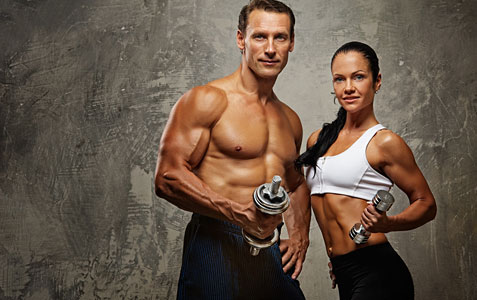
Ask anyone who’s been in the iron game that’s had any type of success and they’ll tell you, “stick to the basics and don’t try and reinvent the wheel.” I couldn’t agree more from a coach/competitor stand point. However, one needs to throw a wrench in their workouts in order to prevent or break through plateaus. Variation is a universal principle that, when applied correctly, can yield incredible results.
One of the most obvious and easiest ways to add variation is to incorporate different exercises into one’s program. Following the first installment in the series, here’s another list of recommended exercises that I’ve rarely seen used.
Band push-ups
Even though training with bands has been around for a while, and used successfully in conjunction with strength training and power lifting, most people who weight train have never been exposed to, let alone used, this outstanding tool.
The laws of physics dictate the specific characteristics of strength curves while performing exercises. The force of movement is more or less dependent on the joint angle during an exercise. For example, in the barbell squat, you may be able to quarter squat 500 pounds, but can only full squat, ass to the floor, 300 pounds. Another common example is the exercise I’m highlighting today: the band push-up. The force at the top of the movement is much greater than the force at the bottom.
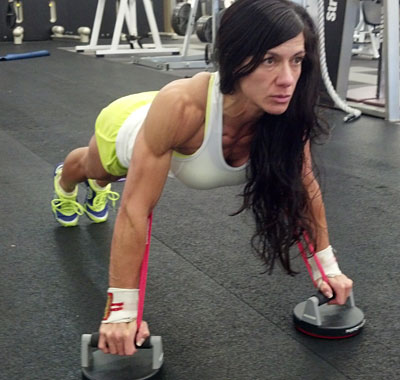
In a nutshell, bands work by applying more resistance where you’re strong and less where you’re weak. Bands accommodate that natural strength curve; this type of training is referred to as accommodating resistance. Researchers addressed strength curves in training as early as 1900 by putting a cam on selectorized machines. The cam on these machines is what accommodates the ability to apply force according to the strength curve. Nautilus equipment is a prime example of this type of equipment.
The biggest problem with training on machines is their inherent lack of individualization. Don’t get me wrong, I use machines and think they have a place even in elite training circles, but they will not accommodate individual differences and should not constitute the bulk of one’s training. Machines limit the natural movement of the body.
If you watch the bar paths while lifters perform exercises (e.g., bench press and deadlifts) with a great degree of intensity, you’ll notice the bar path changes. Top strength and powerlifting coaches will tell you that not only do any two lifters not produce the same bar path, but no lifter performing a set of multiple repetitions will produce exactly the same bar path twice in a row. This is mainly due to fatigue and the body changing the load of specific muscles being used to complete the movement.
The band push-up, although a closed chain movement, is not as restrictive as a machine and can add a welcome variation to any chest building program. Having said that, do your research. Better yet, find somebody in the know who can show you how to properly apply them to your needs.
Using bands should not be taken lightly. It takes a great deal of knowledge, trial and error to use them correctly. A good place to start educating yourself is EliteFTS.com.
• Place the band around your back next to the axilla (armpit), and secure each end in your hands.
• Place your hands outside of shoulder width on the floor or preferably on push-up handles/bars to avoid over extending the wrist. The narrower your hand placement, the more the triceps are involved.
• Keep a straight line from your shoulders to your feet. Looking slightly up or in-line with your body is preferred, but do not look down towards your feet.
• Lower yourself under control until your chest is just above your hands. Going for a big stretch at the bottom of the movement puts undue stress on the shoulder joint.
• To make the exercise even more difficult, pause at the bottom before pressing yourself up.
Incline barbell triceps extension w/ elbows out
Lying triceps extensions, or as some call them, “skull crushers,” are an excellent exercise. The drawback for many is that over time, this exercise can cause pain in the elbow joint and sometimes result in triceps tendinitis. Hence, a large percentage of people drop the skull crusher from their programs.
A great variation to the skull crusher is the triceps extension with elbows out. This exercise is easy on your elbows and yields an outstanding pump in your triceps. It’s technically a multi-joint exercise, but is not an exercise you will be heaving record weight with. It’s a very deceiving exercise in that it looks a lot easier than it is.
As in all exercises, form is essential in this movement. I like the incline variation of this movement the best because it seems to not only hit the lower aspects of the triceps brachii, but hits the long head more so than the flat bench version.
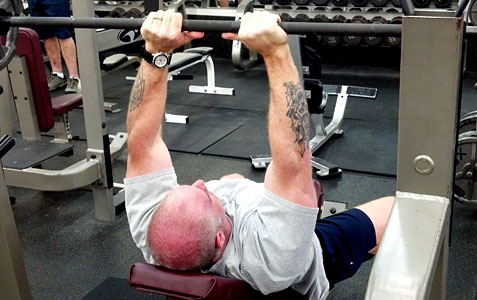

• Center yourself under the bar and grip it with your hands just inside of shoulder width. Carefully lift the bar into position.
• Lower the bar in a controlled manner while pointing your elbows laterally. You want to try and maintain a straight line from elbow to elbow. Stop at the bottom when your elbows just go past 90 degrees.
• To add more difficulty, pause at the bottom before pressing the bar up.
• Do not forcibly lock your elbows out at the top of the movement.
Kneeling dumbbell curls
No other body part exemplifies strength and muscular development like arms. Big muscular arms are in high demand in gyms across this country. Go to any gym and you will always find somebody training arms. The same cannot be said for legs, as is obvious by the lack of leg development in a lot of men who workout.
To ensure that you are training your arms properly, follow the next three principles:
• Variety: Experiment with different workouts. If you’re not happy with your progress, try something new. There are four muscles involved in elbow flexion (as in a dumbbell curl). To train these muscles effectively, you must use a variety of exercises.
• Concentration: Concentration is the key to using proper form and heavier loads. Both of these factors lead to higher muscular tension, which in turn stimulates muscular growth.
• Form, not poundage: The biggest mistake I see people make in the gym is that they sacrifice form for weight. First, this does not allow you to effectively target the muscle being worked. Second, and perhaps most important, improper technique during any exercise can lead to injury.
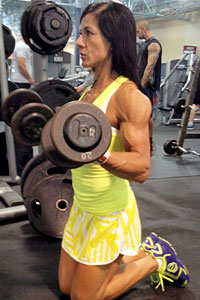
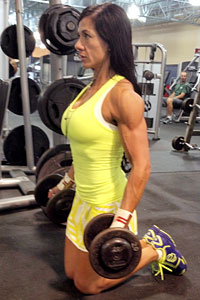
One exercise that I think deserves a place in your program is kneeling dumbbell curls. They are performed just like standing dumbbell curls. However, be prepared to use less weight than you do with standing dumbbell curls. Kneeling helps keep the body from assisting the movement (i.e., you can’t cheat as much).
Give these exercises a try and let me know what you think. Tune in next month for another installment of “Exercises you haven’t done but probably should.”






